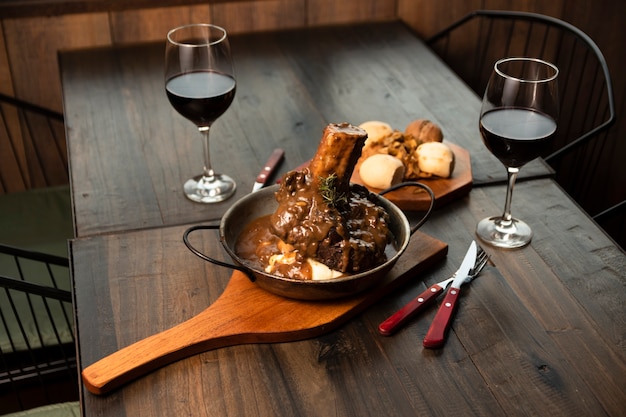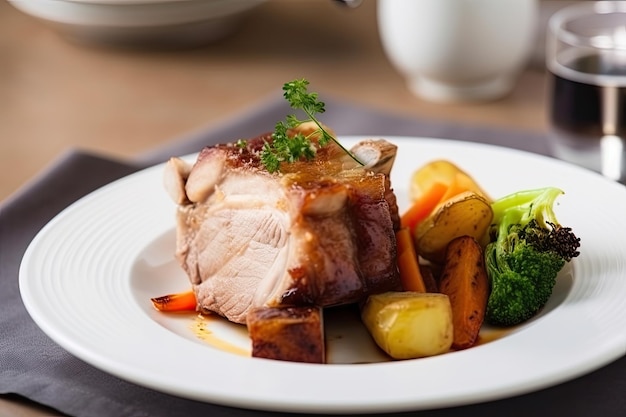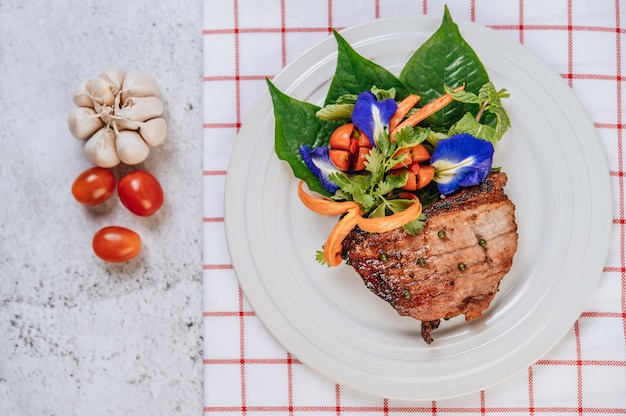Let's face it, the thought of a perfectly cooked filet mignon roast is enough to make anyone's mouth water. Imagine: tender, juicy, and oh-so-delicious, with a beautiful golden crust. It's a dish that screams luxury and sophistication, perfect for impressing guests or simply treating yourself to a truly special meal. But let's be honest, mastering the art of the filet mignon roast can seem a bit daunting.
You've probably heard all the horror stories: dry, tough meat, that dreaded "grey ring," and the fear of overcooking this precious piece of protein. But fear not, my friend! I'm here to guide you through the process, step-by-step, sharing my hard-earned wisdom and tips to ensure your next filet mignon roast is a resounding success.
Together, we'll explore the secrets of choosing the perfect cut, mastering the art of seasoning, understanding the crucial role of resting, and discovering various cooking methods to achieve that perfect balance of tenderness and flavor. I'll even unveil the magic of temperature checks and reveal my go-to side dishes and sauces to complete your culinary masterpiece. So, grab your apron, gather your ingredients, and let's embark on this delicious adventure together.
(Part 1) The Foundation: Choosing the perfect filet mignon

The Meat of the Matter: Understanding the Cut
First things first, we need the right piece of meat. And when it comes to filet mignon roasts, not all cuts are created equal. Forget those thin, "filet mignon" medallions you find in the supermarket. We're aiming for a proper roast, a thick, beautiful piece of meat that's going to make a statement.
The ideal choice is a center-cut filet mignon, also known as a "chateaubriand." Look for a cut that's at least 2 inches thick, ideally 3-4 inches. This thickness allows for even cooking and ensures a juicy, tender result. You can usually find these beauties at a good butcher shop or in well-stocked supermarket meat departments.
Marbling: The Key to Tenderness and Flavor
While choosing a thick cut is essential, don't forget to pay attention to marbling. Those little white streaks of fat are crucial for flavor and tenderness. Marbling helps distribute moisture throughout the meat during cooking, preventing dryness and adding a rich, buttery taste. Aim for a piece with good marbling throughout, avoiding cuts that are too lean.
Sizing It Up: Determining the Right Roast
The size of your roast will determine how long it takes to cook, so consider the number of people you're serving and your desired portion size. For a small gathering or a romantic dinner for two, a 2-pound roast is ideal. If you're planning a larger feast, a 3-4 pound roast will ensure there's plenty to go around.
The Art of Trimming: A Quick and Simple Step
Once you have your prime cut, a little trimming is in order. Don't get too carried away, but remove any excess fat or silver skin (the tough, white membrane). This helps ensure a clean, even cook and allows the flavors to shine through. Remember, we want to keep the fat on the edges, as it will help keep the meat moist and flavorful.
(Part 2) Laying the Flavor Foundation: Mastering the Art of Seasoning

Keeping it Simple: The Power of Salt and Pepper
Seasoning is a critical aspect of any roast, and with filet mignon, simplicity often reigns supreme. A good pinch of salt and freshly ground black pepper is all you truly need to unlock the meat's natural flavors. Salt, generously applied, draws out moisture, enhancing the meat's inherent taste.
Don't be afraid to use a liberal amount, especially if you're seasoning the day before. Aim for about 1 teaspoon of salt per pound of meat, and let the seasoning work its magic as the meat rests in the fridge.
Beyond the Basics: Adding Depth of Flavor
Now, for those who like to experiment, there's a whole world of flavor possibilities to explore. Herbs like rosemary, thyme, and garlic powder can add a touch of warmth and complexity. A dash of paprika, cayenne pepper, or cumin can introduce a bolder spice profile.
Remember, when it comes to seasoning, less is more. A little bit goes a long way, and you don't want to overpower the delicate flavor of the filet mignon. Experiment with different combinations, but keep the seasoning simple and avoid overwhelming the natural deliciousness of the meat.
(Part 3) The Power of Patience: Resting the Roast for Optimal Tenderness

Unlocking the Secrets of Resting: Why It's Crucial
One of the most common mistakes people make when cooking a roast is skipping the resting step. You might be tempted to carve into that beautiful, golden-brown roast immediately, but I assure you, patience is key here. Resting is crucial for achieving the ultimate level of tenderness and flavor.
After cooking, let the roast rest for at least 15 minutes, preferably 20, before carving. This seemingly simple step allows the juices to redistribute throughout the meat, resulting in a more tender, juicy, and flavorful final product.
The Science Behind Resting: Understanding the Muscle Fibers
So, what's happening during those precious resting minutes? Well, it all comes down to the muscle fibers. When you cook a roast, the heat causes the muscle fibers to contract, squeezing out the juices. As the meat rests, the fibers relax, allowing the juices to escape and redistribute throughout the meat. This creates a more even distribution of moisture and flavor, resulting in a more tender and enjoyable eating experience.
Creating a Resting Ritual: The Perfect Way to Let the Roast Relax
Here's my usual resting ritual: I wrap the roast loosely in tin foil, keeping it insulated and preventing it from cooling too quickly. I then place it on a cutting board and let it rest while I prepare the accompanying sides, such as roasted vegetables or a creamy sauce. This allows the roast to cool slightly and prevents it from becoming dry while I focus on the rest of the meal.
(Part 4) Mastering the Heat: Exploring Different Cooking Methods
The Classic oven method: A Reliable and Consistent Choice
Let's start with the tried-and-true oven method. It's a reliable choice, perfect for those who prefer a hands-off approach. Preheat your oven to 400 degrees Fahrenheit (200 degrees Celsius). Place the seasoned roast on a baking sheet, ensuring it's not overcrowded. Cook for 10-15 minutes per pound, or until the internal temperature reaches 130 degrees Fahrenheit (54 degrees Celsius) for medium-rare.
I always recommend using a meat thermometer to check the temperature. It's the best way to ensure your roast is cooked to perfection. Insert the thermometer into the thickest part of the roast, making sure it doesn't touch any bone. Don't worry, we'll delve deeper into temperature checks later on.
The Cast Iron Method: For a Crispy Crust and Smoky Flavor
Now, for those who crave a bit more heat and char, the cast iron method is for you. Preheat your cast iron skillet over medium-high heat. Sear the roast for 3-5 minutes per side, achieving a beautiful golden crust and imparting a delicious smoky flavor.
Once the roast has a nice sear on all sides, transfer the skillet to a preheated oven at 400 degrees Fahrenheit (200 degrees Celsius). Cook for another 10-15 minutes per pound, or until the internal temperature reaches 130 degrees Fahrenheit (54 degrees Celsius) for medium-rare.
The reverse sear Method: Achieving Even Cooking and Ultimate Tenderness
This method is a bit more time-consuming but yields incredibly tender, evenly cooked results. It involves a long, slow cook at a low temperature followed by a quick sear to create a beautiful crust.
Preheat your oven to 250 degrees Fahrenheit (120 degrees Celsius). Place the roast on a baking sheet and cook for 1 hour per pound, or until the internal temperature reaches 120 degrees Fahrenheit (49 degrees Celsius). Once the roast has reached this temperature, increase the oven temperature to 450 degrees Fahrenheit (230 degrees Celsius) and cook for another 10-15 minutes, or until the internal temperature reaches 130 degrees Fahrenheit (54 degrees Celsius) for medium-rare.
(Part 5) Temperature Check: The Key to Perfectly Cooked Filet Mignon
Beyond Guesswork: The Importance of a Meat Thermometer
Don't rely on your gut feeling or visual cues when cooking filet mignon. The only way to ensure your roast is cooked to your desired level of doneness is to use a meat thermometer. It's a simple tool that takes the guesswork out of cooking, ensuring a consistently delicious result.
The Doneness Guide: Understanding Internal Temperatures
Here's a handy guide to internal temperatures for different levels of doneness:
| Doneness | Internal Temperature (°F) | Internal Temperature (°C) |
|---|---|---|
| Rare | 125-130 | 52-54 |
| Medium-Rare | 130-135 | 54-57 |
| Medium | 135-140 | 57-60 |
| Medium-Well | 140-145 | 60-63 |
| Well-Done | 145-150 | 63-66 |
Adjusting for Perfection: When to Modify cooking time
Don't be afraid to adjust the cooking time based on the internal temperature. If your roast is coming along too quickly, reduce the oven temperature by 25 degrees Fahrenheit (12 degrees Celsius). If it's taking longer than expected, increase the temperature by the same amount. Keep a close eye on the thermometer and be prepared to make adjustments as needed.
(Part 6) Rest, Relax, and Carve: The Final Steps to Culinary Bliss
The Art of Resting: Allowing the Juices to Redistribute
Once your roast has reached the desired internal temperature, remove it from the oven and let it rest for 15-20 minutes before carving. This is crucial for allowing the juices to redistribute throughout the meat. It's like giving the roast a chance to settle down and relax after all that heat, ensuring a succulent, flavorful result.
Carving with Confidence: Techniques for Perfect Slices
Use a sharp knife to carve the roast into thin slices, working against the grain. This prevents the meat from becoming tough and ensures a tender, melt-in-your-mouth experience. If you're feeling fancy, you can arrange the slices on a platter, with some of the juices drizzled over the top.
(Part 7) Symphony of Flavors: Accompanying Delights and Perfect Pairings
The Art of Accompaniment: Sides That Complement the Roast
No filet mignon roast is complete without the perfect sides. Roasted vegetables, such as asparagus, Brussels sprouts, or carrots, provide a beautiful contrast in color and texture, and complement the richness of the meat.
A creamy potato gratin or a simple side of mashed potatoes offers a comforting, decadent pairing. And don't forget the power of fresh greens. A light salad with a vinaigrette dressing adds a refreshing touch and balances out the richness of the roast.
A Touch of Elegance: Sauces That Elevate the Experience
A creamy sauce is a must-have for elevating your filet mignon roast. You can go with a classic béarnaise sauce, or explore more adventurous options like a mushroom sauce, a red wine reduction, or a simple herb butter.
These sauces not only add flavor but also help to create a visually appealing presentation. A drizzle of sauce over the sliced roast and a dollop on the side add a touch of sophistication.
Presentation Matters: Creating a Visually Appealing Plate
Presentation is key for any meal, especially when serving a dish as elegant as filet mignon roast. Arrange your sides beautifully on a platter, creating a visually appealing display. You can even add a sprig of fresh herbs or a drizzle of balsamic glaze for a touch of elegance.
(Part 8) The FAQs: Answering Your Burning Questions About Filet Mignon Roast
Q1: Can I cook filet mignon from Frozen?
It's not recommended to cook filet mignon from frozen. It will result in an unevenly cooked roast, and the meat may become dry and tough. Always thaw the roast overnight in the refrigerator before cooking to ensure optimal results.
Q2: How Do I Know If My Roast is Done?
The best way to tell if your roast is done is to use a meat thermometer. Insert the thermometer into the thickest part of the roast, making sure it doesn't touch any bone. Check the internal temperature against the chart provided earlier.
Q3: Can I Overcook Filet Mignon?
Absolutely! Overcooked filet mignon will be dry and tough. That's why using a meat thermometer and cooking the roast to your desired level of doneness is crucial.
Q4: What Happens If I Don't Let the Roast Rest?
If you don't let the roast rest, the juices will run out when you carve it, resulting in a dry and less flavorful roast. Letting it rest allows the juices to redistribute throughout the meat, creating a more flavorful, tender result.
Q5: What If My Roast Isn't Pink Enough?
If your roast isn't pink enough, it's likely overcooked. Unfortunately, there's not much you can do to reverse that. But don't worry, you can still enjoy a delicious meal. Just be sure to slice the roast thinly, and add a rich sauce or gravy to compensate for the dryness.
Everyone is watching

How to Cook Frozen Lobster Tails Perfectly: A Step-by-Step Guide
RecipesLobster. Just the word conjures up images of lavish meals, special occasions, and a taste of luxury. But let's...

Pigs in a Blanket Cooking Time: How Long to Bake for Perfect Results
RecipesAh, pigs in a blanket. Just the name conjures up images of those delightful little parcels of crispy pastry en...

Pork Fillet Cooking Time: How Long to Cook It Perfectly
RecipesPork fillet, or tenderloin as it's sometimes called, is a real favourite in our house. It's so versatile, and...

The Ultimate Guide to Tender, Juicy Pulled Pork
RecipesRight, let's talk pulled pork. It's one of those dishes that just screams "comfort food," doesn't it? I mean...

The Ultimate Guide to Cooking Sweet Potatoes: From Roasting to Mashing
RecipesSweet potatoes. Just the name conjures up images of warm, comforting dishes, bursts of vibrant color, and a to...
